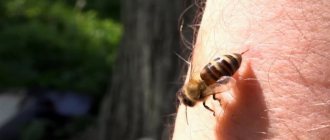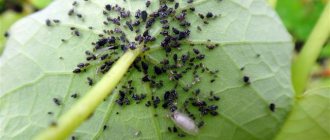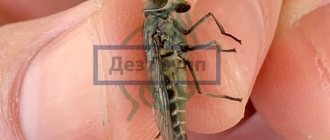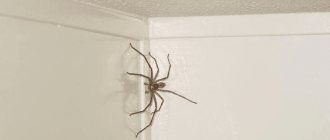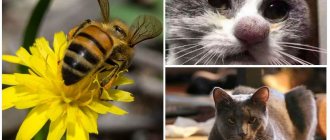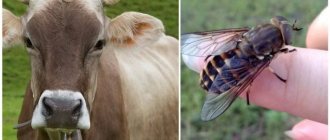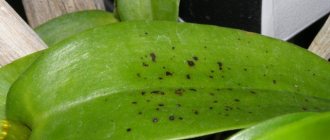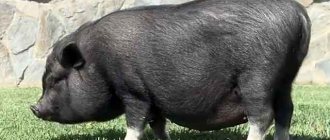The bee is a hardworking and beautiful insect. It doesn’t waste a minute, buzzes, flies from flower to flower, collecting pollen, and can easily attract the attention of adults and children.
But do not rush to touch it - in defense, this insect stings. Its bite can be dangerous to health: older people, children and people with allergies can suffer more harm.
Let's take a closer look at the reasons why it stings and what to do at home if you are bitten by a bee.
Why are bee stings dangerous?
If a person is stung by a bee, this can pose a real danger to his health and life. In most cases, swelling appears at the affected area, which looks like a lump. After a few hours it subsides. However, for some people, such injuries provoke serious consequences.
The most severe reaction after a bee or wasp sting is anaphylactic shock. This condition is accompanied by the following symptoms:
- severe swelling of the neck and larynx;
- breathing problems - it becomes more frequent, wheezing appears;
- a sharp decrease in pressure, thread-like pulse;
- the appearance of dizziness;
- fainting state.
Bites to the face are especially dangerous. Even in the absence of allergies, a person may experience severe swelling that does not subside for a long time. Impacts are transferred even worse to the tongue. It can swell greatly and block the supply of oxygen.
In such a situation, urgent medical attention is required. Multiple bee stings pose a great danger. Complications are also highly likely to occur in the child.
Antiallergic drugs
In case of a bite in the face or lip, or the onset of an acute allergy, it is necessary to give injections rather than give tablets: the latter act too slowly, and the stung area swells very quickly. Therefore, dog breeders should purchase a couple of ampoules of the following drugs so that they are always on hand in their home veterinary medicine cabinet. You should also take the ampoules with you during trips to nature - to keep them safe and sound, wrap them in foil.
- You can buy suprastin or tavegil in ampoules at the pharmacy without a prescription. Diphenhydramine is also suitable - but, unlike the previous ones, it is available with a prescription.
- Dexamethasone, also in ampoules.
In case of severe swelling, some veterinarians recommend additionally injecting the dog with a diuretic (furosemide) and magnesium.
Signs of a bite
There are several main signs that a person has been bitten by a bee:
- severe burning pain;
- redness of the skin and the appearance of a white dot in the central part;
- rapid appearance of edema.
Most often, everything is limited to these symptoms. However, some people experience allergy symptoms. In this case, the following manifestations are observed:
- severe swelling in the bite area, which rapidly increases;
- severe itching and rashes all over the body;
- breathing problems resembling an asthma attack;
- nausea and vomiting.
What to do at home if bitten by a bee
Immunity to bee venom is unstable, and even among beekeepers with extensive experience it disappears by spring.
The illustration for the text was obtained from the open source Yandex pictures
What to do if bitten by a bee, treatment:
- It is necessary to remove the sting from the victim with tweezers, without crushing the sac of poison, otherwise more poison will get under the skin.
- Wipe the bite area with ammonia or alcohol tincture of calendula. If possible, pull the tourniquet above the bite site.
- Apply ice to the area itself for up to 15 minutes.
- Treat the bite site with antiallergic ointment.
- In case of severe poisoning, give the victim a lot of water, heart drops, antiallergic drugs and send to the hospital.
Classification
Bee stings can be single or multiple. In the first case, sharp and burning pain occurs in the affected area. You can also see that the area is swollen and red. Multiple bites are considered more dangerous. They pose a real threat even to people who do not have allergies.
Also, stings are classified depending on the type of bee. Thus, people are bitten by both domestic and wild insects. It is worth noting that in the second case the risk of developing allergies is significantly higher.
Types of blood-sucking and stinging insects
Many insects bite and sting, but few do it intentionally. Most bites are relatively harmless, leaving only an itchy patch of skin.
But some insects can be carriers of serious diseases, and then the bites pose a danger to humans.
Insects that bite intentionally:
- mites;
- bedbugs;
- fleas;
- lice;
- midges;
- mosquitoes.
Many large insects will not specifically seek out prey to sting, but will bite if they feel threatened. Usually the sting of a bee or ant contains poison. When it is injected into the skin, a sensation of itching and pain occurs.
Stinging insects:
- bees;
- hornets;
- wasps;
- red forest ants.
First aid
If a person has been bitten by bees, he needs timely assistance. It is recommended to do the following:
- Carefully inspect the bite area. There should be a sting in the center.
- Be sure to remove the sting. This can be done with your fingernails or tweezers.
- Treat the damaged area with an antiseptic at home.
- Apply cold to the damaged area. It is important to use only clean objects to avoid introducing infection into the wound.
- Apply a soda compress to the damaged area and hold for 15 minutes. To prepare the solution, you need to mix 1 small spoon of baking soda with a glass of water.
- Apply a topical antihistamine to the affected area. For this you can use “Fenistil” or “Psilo-balm”.
- Take an antihistamine. This must be done if there is a violent reaction in the body. Antihistamines are also recommended for bites to the head.
See also
Features of double-hull keeping bees in a hive - pros and cons of hivesRead
There are also many folk remedies that can be used as first aid to the victim. The most effective products include the following:
- Parsley – has anti-inflammatory properties. To use this plant, you need to pour boiling water over the green leaves and put them in hot water for 5 minutes. After this, you should apply warm leaves to the bite site.
- Aloe – helps cope with swelling, itching and redness. To eliminate unpleasant symptoms, you should use compresses with aloe decoction or apply leaves to the bite area.
- Onion – has bactericidal properties, eliminates hyperemia and swelling. To get rid of unpleasant symptoms, it is recommended to apply compresses with onions.
To reduce the concentration of the poison and speed up its elimination, you need to give the victim a lot to drink. Plain water, tea, compote are suitable for this. Usually, these measures are enough to prevent the negative consequences of a bite.
When providing first aid, it is important to take into account the location of the lesion. If you are bitten on the neck or head, there is a higher risk of developing an allergy. If a bee bites you on the leg, the likelihood of dangerous consequences is much lower. The same applies to bites on a finger on the hand.
Photos of people stung by bees
Despite its beneficial properties, a bee sting causes significant discomfort. In order not to face its consequences, it is necessary to take preventive measures in time. It is advisable to avoid places where insects gather. People who drink alcohol should be especially careful, as bees react to the smell of ethanol. After discovering a bite, it is recommended to consult a doctor. This will help you get the most benefits from an unpleasant incident. On average, the recovery process takes 2-7 days. Photos of people who were stung by bees are shown below.
Further treatment
Most often, after providing first aid, nothing needs to be done. Sometimes it is necessary to smear the affected area with antihistamines. This will help relieve swelling. It is important to consider that 2% of people experience an allergic reaction to bites. They can lead to negative consequences, including death. In such a situation, you need to consult a doctor.
Urgent medical care is needed in the following cases:
- Multiple bites. In such a situation, a high concentration of bee venom can cause negative consequences, including respiratory arrest.
- Bites to the eyes, mouth area, neck. In the first case, there is a risk of developing serious inflammation of the visual organ. In this case, damage to the neck and oral cavity can provoke suffocation due to swelling of the tissues of the respiratory tract.
- Allergic reactions. Dangerous symptoms include shortness of breath, sore or cramping throat, and a feeling of tightness in the chest. There is also a risk of massive swelling, rashes, nausea and vomiting. Some people experience breathing problems and fainting.
See also
What exactly do bees eat in nature and in the apiary? Do insects eat honey? Read
In such situations, you need to call an ambulance or take the victim to a medical facility yourself. A doctor's consultation is also required if severe swelling and redness in the affected area persists for 3 days. In such a situation, the specialist will prescribe medications that will eliminate these symptoms. An antihistamine usually helps in such cases.
External differences
The variety of wasps and bees is great, and sometimes there are species that look like a fly or a winged ant. It will be more convenient to consider the differences between bees and wasps in the photo, which shows the most common species - honey bees and true wasps.
The wasp has a brighter color.
The head, belly and chest are separate, all parts of the body are clearly visible regardless of the size of the insect. The belly and chest are separated by a thin waist, allowing the insect to bend almost double. This quality helps during hunting. The upper jaw is well developed for grinding protein foods. The powerful mouth is also used for housing construction: gnawing holes, collecting building materials.
The wasp's eyes have a complex structure, and the visual organ has 3 small additional eyes located on the head in the form of a triangle. A predator insect can see 180⁰ around itself. Wasps cannot see small details, but are very sensitive to flickering light.
The insect's body has 3 pairs of legs, which have a complex structure. They have muscles and are mobile. Some types of insects can not only crawl on the surface, but also run quickly.
Bees have a more uniform color, and the brightness of color transitions is smoothed out by the presence of villi.
If a wasp has an elongated, oval head, then a bee’s head depends on its membership in the hierarchical level in the hive. The most rounded head is found in drone bees; working individuals have a triangular head; in queens it is something between a round and triangular shape.
The mouth has hard jaws for chewing the anther of the flower. The jaws are also used to build a hive and remove debris. However, not all bees have a developed oral region, but only workers and the queen, who are forced to arrange the hive, provide for and protect the offspring.
The part of the body intended for collecting nectar is called the proboscis. The most developed proboscis in worker bees.
The body structure of insects is similar. The bee also has a rump, chest, and belly, connected by a cuticle, but usually there are no difficulties in distinguishing a wasp from a bee: the latter do not have a pronounced wasp waist.
Bees have large, faceted eyes, and like wasps, they see everything in the form of a mosaic that forms a whole picture.
Prevention
To avoid bee stings, you need to follow simple recommendations:
- If a bee flies very close, you should not try to drive it away. It is important to remain calm and not make sudden movements until the insect flies away.
- Experts do not advise being afraid of bees. Many scientists claim that insects sense how adrenaline is produced.
- Don't wear bright clothes that attract bees.
- It is not recommended to use perfumes and deodorants that have strong odors. They attract insects.
- You should not walk barefoot on the grass.
Bee stings can pose a real danger to human health and life. Therefore, it is important to provide first aid to the victim in a timely manner. If allergy symptoms appear, a person must be immediately taken to a medical facility.
Useful tips
- Bees are attracted to sweet smells. When going for a walk in nature, try not to use perfume with the aroma of flowers and sweet notes.
- If an insect flies close or lands on clothing, there is no need to make sudden movements. The bee is not aggressive and will calmly leave you soon if you do not start waving your arms, screaming and fussing.
- When walking in the forest, wear closed shoes and trousers. Bees may be found in low-growing flower bushes.
- The victim of a bite is advised to drink more, water will quickly remove toxins from the body.
- Diuretic herbs also reduce swelling.
- When dining outdoors, it is advisable to clean up after yourself as soon as possible. The smell of certain foods attracts many stinging insects.
- You should stay away from bee apiaries. You should not approach them out of curiosity without special protective equipment.
- Sun rays intensify skin reactions. It is advisable to protect the bite site from ultraviolet radiation.
- A person who has been bitten should not drink alcohol under any circumstances; this will enhance the effect of the poison and can cause the most severe consequences.
- Install protective nets on windows in the summer.
A bee sting is an unpleasant and sometimes dangerous thing. If allergic symptoms increase, you should immediately call an ambulance or take the victim to the hospital yourself.
Sources
- https://upchel.ru/pchelovodstvo/pomoshh-ukuse
- https://parazitdoma.ru/sovety/uksus-pchely-chto-delat-kogda-vas-uzhe-ukusili-pervaya-pomosch-preparaty-i-domashnie-sredstva-i-chto-delat-kategoricheski-nelzya
- https://www.ayzdorov.ru/lechenie_ykys_pcheli.php
- https://bolezni-kozhi.ru/kak-snyat-otek-ot-ukusa-pchely.html
- https://GdeKlop.ru/osy-i-pchely/pravila-pervoj-pomoshhi/
- https://www.neboleem.net/pervaja-pomoshh-pri-ukuse-pchely.php
- https://pchela-info.ru/pchely/pervaya-pomoshh-pri-ukusah
- https://www.polismed.com/articles-ukus-pchely-osy-chto-delat.html
- https://plannt.ru/otek-posle-ukusa-osy-ili-pchely
- https://7ogorod.ru/prochee/ukusila-pcela-snat-opuhol.html
[collapse]
